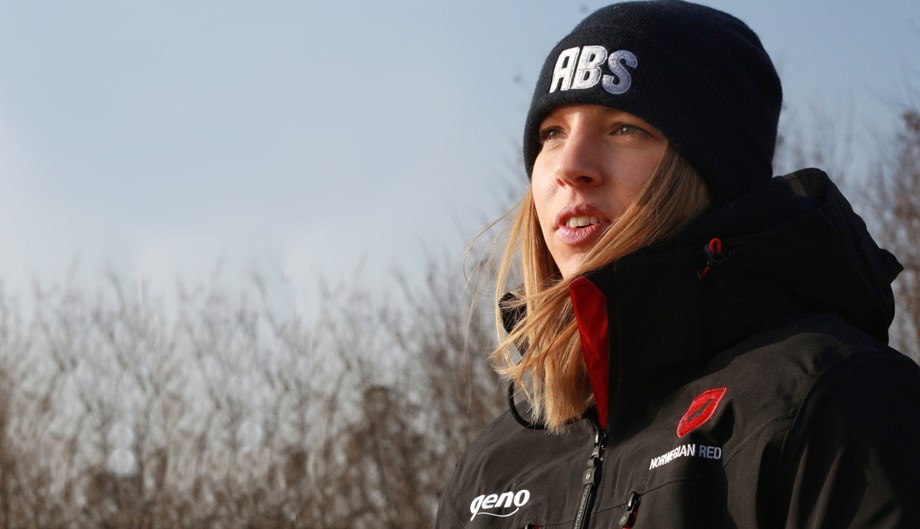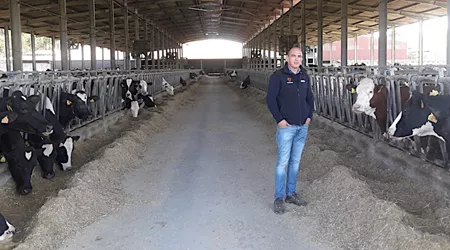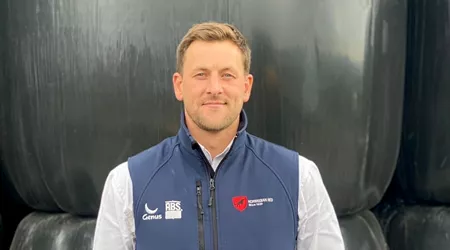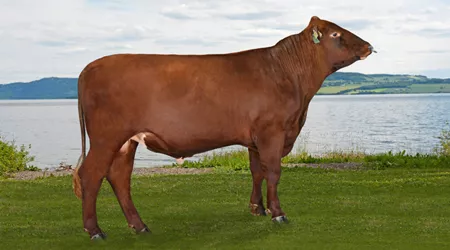Crossbreeding is a concept that still needs to be explored by many farmers in Italy, but we have seen more and more acceptance and improvements in the past years. There has been much debate around crossbreeding, and this is a positive signal!
I have been part of Geno and ABS’s cooperation since January of 2020 when I joined ABS as HYVIG product specialist. HYVIG is the crossbreeding concept developed and launched in 2016 by ABS and Geno focusing on specific markets namely the United States, Canada, UK, France, Italy, Australia and Russia.
I have a background in science and animal production and graduated from The University of Padua in Italy. I have had, particularly, strong attention to all things related to reproduction physiology and fertility issues in dairy cows. My previous job on a dairy farm has prompted me to look for something closer to bovine genetics with a technical support role.
The dairy industry in Italy - more emphasis on milk quality rather than simply yields
Italy still possesses a strong tradition when it comes to the dairy industry and is still an important player in Europe. It accounts for about 10% of EU milk deliveries and 50% of Italy’s bovine milk is designated for the production of "Protected Designation Origin" cheese (50 are recognized and protected by EU), such as Grana Padano and Parmigiano Reggiano, just to name a few of the most important.
Dairy herds are located all over the territory, and the northern part of the country accounts for the vast majority of them, with “high-input/out-output” as the most represented system of management. Lombardia region is by far the most important region that produces 45% of Italian milk.
There are a total number of 1,7 million dairy cows in Italy with Holstein as the dominant breed. Around 10,000 herds are registered in the National Holstein Association (accounting for 1,100,000 cows) with a milk yield average of 10,300 Kg, 3.79% fat & 3.35% protein.
In Italy, there has been a general trend to give more emphasis on milk quality rather than simply yield.
Like many EU countries, Italy is also witnessing several changes in the industry: stability of the number of cows with a drop in the number of herds, and an increase in technology adoption, both for smaller and larger herds. There is also a significant increase in milking robots due to the challenges in hiring skilled manpower and farming cost/benefits.
Norwegian Red and their daughters in the eyes of Italian dairy farmers - “Another year with no calves loss!”
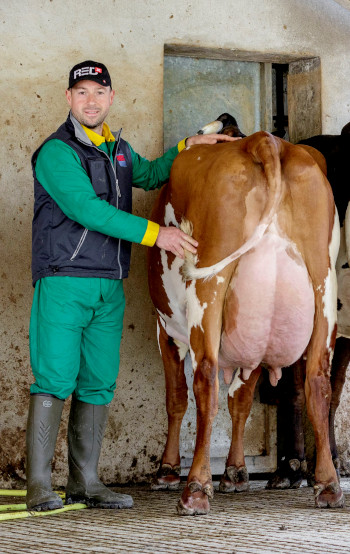
Carlo Aceti with a beautiful Norwegian Red x Holstein crossbred cow, daughter of NR11078 Gopollen. Photo: Luca Nolli
To me, receiving a combination of good data with success stories from farmers shows a validation that we are providing them with the right products and solutions.
The most rewarding feeling I have when I visit dairy farmers is to hear their stories on how they are enjoying the benefits from the products we sell, and that includes the benefits of using Norwegian Red genetics:
- Better fertility performance, more vital calves, added robustness
- Cows that last longer with a more average number of lactations
- Competitive milk production in comparison to Holsteins
- Cows that are easier to manage.
We have customers that have started introducing Norwegian Red genetics 10 years ago, and since then, they have experienced steady improvement in fertility performance and fewer issues related to health problems, such as a decline in mastitis frequency and lameness. This has obviously been beneficial for farmers to increase their profitability and for improving animal welfare.
I also use my time to meet with farmers to collect good stories, data, and testimonials that I can share with our team in ABS. I enjoy receiving messages and photos directly on my phone from farmers with Norwegian Red in their herd, especially pictures of their very first Norwegian Red calves. It is so gratifying to get some updates on good performances, and one of the best texts and photos I received from a farmer was one that says, “another year with no calves loss!”.
Storflor and Skjelvan - Most popular Norwegian Red bulls in recent times
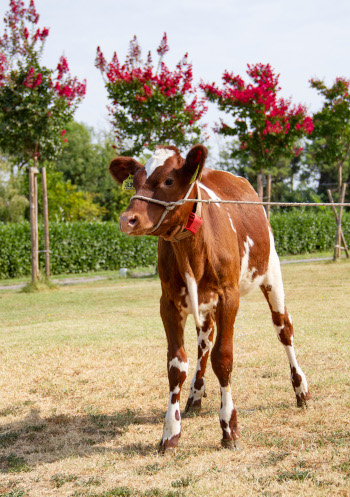
Daughter of the popular NR sire 12027 Storflor, 4 months old, Az. Agr. Brusati, Bellinzago Novarese, Italy. Photo: Angela Bressan
It is important for us to continue to offer the best genetics that can anticipate the needs of the Italian dairymen.
NR11039 Skjelvan has been extremely popular and is still used by our local dairy farmers. He has shown positive results for protein yield and is in high demand because he is BB for kappa casein. Many of his daughters are still in milk and performing really well. His daughters also have good udder depth and good attachments, despite the teats that can be a bit short sometimes.
I am also excited to say that, right now, NR12027 Storflor is considered the most interesting Norwegian Red bull we have to offer. We are expecting great things from him, and I look forward to seeing the excellent performance of his daughters in the future, as so far, I see that the heifers are looking very promising. Storflor has also produced some really great sons in Norway, and they will soon become available for the international markets, and I am excited to have his first sons to promote in Italy.
The perception of crossbreeding in Italy
Many Italian farmers and others in the industry are still skeptical when they hear the word “crossbreeding,” a topic that is still discussed with bias. Crossbreeding really is a good option for many farmers, but it is not for all farmers. Crossbreeding will not magically make all problems disappear, so it is important for us to provide good advice for farmers so they can manage their expectations from crossbreeding results. Farmers also need to select the right breeds and the right bulls within the breeds since this is key to having successful results.
Interestingly, we have seen a strong increase in acceptance of crossbreeding and a better perception of crossbreeding in the past years. There has been much debate around crossbreeding, but this is a positive signal. Having said that, we need to continue to promote and create awareness for crossbreeding, because it is a concept that still needs to be explored or understood by many dairy farmers.
For us in ABS, providing advice along with achievable expectations is especially important. Our goal is to build a long-term relationship with our customers and deliver the result they expected, with no unwanted surprises. Farmers have their own unique needs, and we need to constantly engage with them to understand and anticipate those needs, and that is also by giving them the proper support and making the right suggestions as part of my daily job.
By continuously promoting crossbreeding, I also get the opportunity to talk about the many benefits of crossbreeding with Norwegian Red, especially to farmers who are looking for a faster way to achieve improved genetic gain compared to pure breeding. It is important to focus on the objectives of the farmers since there are some necessary steps to consider in crossbreeding just as in pure breeding.
The main trends in Italy and the type of cow the Italian farmers should expect in five years
The global pandemic, an increase in feed price, animal welfare, sustainability, challenges with the workforce, volatility in milk price, and the growing pressure to reduce antibiotic use in dairy cows have certainly led dairy farmers to change the way they have to re-think their business and operations.
Having pretty-looking cows producing high milk yields is no longer enough to maintain a sustainable farm. Good health and fertility performance are needed, and most farmers agree that cows should last longer with a better lifetime of production than they are today. It is also a matter of profitability, and we know that genetics plays a crucial role in this.
Our strategy of using sexed semen on the best animals and beef semen on those with the lowest genetic merit has been successful and growing in demand. It is so motivating to see the progressive thinking of dairy farmers who are constantly looking for innovative solutions to help them stay relevant with the changing trends. And the foundation of our commitments in ABS has been to provide tailored breeding strategies and products for the farmers, with crossbreeding as one of our valuable solutions.
The most important traits when you select Norwegian Red sires for Italy
Norwegian Red is superior when it comes to fertility and health traits, and for this reason, I am not too focused on selecting bulls that are extremely positive in those areas.
In the past years of engaging with our customers, I have learned that selecting bulls with very good milk solids indexes, udder conformation, and high milk yield is the perfect criteria for our market. Calving ease is also important, considering the growing demand for sexed semen that is often used on heifers. Beta casein A2A2 is truly relevant, and we are in a favorable position since most Norwegian Red sires are A2A2. Beta casein BB is a good plus to the bulls I select from Norway.
Experience on Norwegian Red when it is crossed with other breeds than Holstein
We have many experiences there, with some customers that have decided to introduce Norwegian Red into their Fleckvieh herds sharing really positive feedback. Fleckvieh farmers have seen that Norwegian Red crossbred daughters have given them improved udder quality compared to their Fleckvieh dams. They have reduced the size and live weight and have gained milk yield while maintaining good milk quality. Undoubtedly an excellent value Norwegian Red can offer also to Fleckvieh farmers.
The main drivers of dairy farmers to start crossbreeding with Norwegian Red
I first try to understand the objectives of the farmers and what type of cow they would like to have. Most of the time, their answer around ideal cow is: “a good producer, easy to get back in calf, keeps a good body condition, and can last for many lactations without significant issues.”
Crossbreeding is the right option for those who want to combine Holstein's traits with the unique traits of Norwegian Red genetics that has more than 50 years of track record in producing healthy and fertile dairy cattle breeds. In other words, crossbreeding will allow farmers to combine the best of both breeds to achieve faster genetic improvement, already from the 1st generation of daughters.
Best part of working with ABS Italy
I like the daily challenges my job offers me. It motivates me and has helped me to develop myself to grow within my role and in the industry. There is so much valuable knowledge I gained from meeting the customers and from interacting with my colleagues around the world. I really enjoy meeting customers and to support Italian farmers and the industry in the best possible way.
